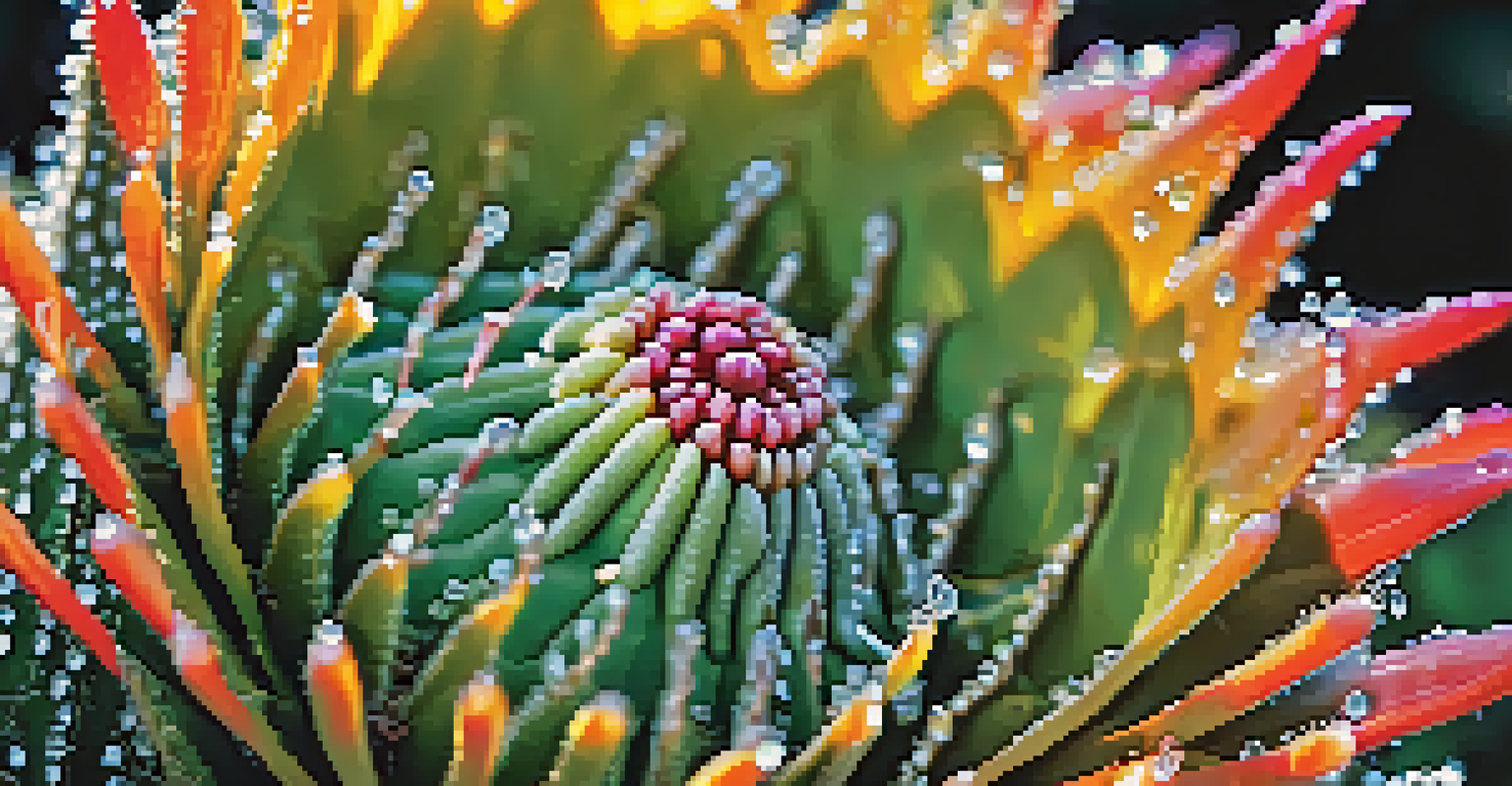Exploring Peyote: Gateway to Altered States of Consciousness

What is Peyote and Its Historical Significance?
Peyote is a small, spineless cactus native to Mexico and the southwestern United States, renowned for its psychoactive properties. For centuries, various indigenous cultures have used it in spiritual rituals and healing practices, believing it connects them with the divine and enhances their understanding of the universe. Understanding its historical significance helps us appreciate the cultural contexts in which peyote has been revered.
The journey of self-discovery is not a straight line, but a spiral that leads us deeper into our own understanding.
The indigenous peoples, particularly the Huichol and the Navajo, have incorporated peyote into their spiritual practices, often seeing it as a sacred gift from the gods. These traditions emphasize the importance of respectful use and the belief that peyote offers guidance and insight. This deep-rooted connection to spirituality sets the stage for its exploration in modern contexts, where people seek personal transformation and healing.
Today, peyote continues to be an essential element of Native American Church rituals, serving as a powerful tool for communal bonding and personal introspection. However, its use is also subject to legal restrictions, raising questions about cultural appropriation and the importance of preserving these sacred practices. As we delve deeper into the effects of peyote, it’s crucial to honor its historical roots.
The Active Component: Mescaline
At the heart of peyote's effects is mescaline, a naturally occurring psychedelic compound. Mescaline is known for inducing altered states of consciousness, characterized by vivid visual hallucinations and profound emotional experiences. By understanding mescaline, we can better grasp the transformative potential of peyote and its role in spiritual exploration.

When consumed, mescaline interacts with serotonin receptors in the brain, leading to changes in perception, mood, and cognition. Users often report heightened senses, deeper connections with nature, and insights into their own lives. These experiences can be deeply personal, providing clarity and perspective that might be hard to achieve in ordinary states of awareness.
Peyote's Cultural Significance
Peyote has deep roots in indigenous cultures, where it is viewed as a sacred plant integral to spiritual rituals and healing practices.
However, the journey with mescaline isn't always smooth. Some individuals may experience anxiety or discomfort, often referred to as a 'bad trip.' This underscores the importance of setting intentions and creating a safe environment for such explorations, ensuring that the experience is as beneficial as possible.
Cultural Context and Ethical Considerations
As interest in peyote grows, so do discussions about its cultural significance and ethical use. Many indigenous groups emphasize that peyote is not just a substance for recreation but a sacred plant that requires respect and understanding. Engaging with peyote outside its traditional context raises important questions about cultural appropriation and the commercialization of indigenous practices.
Nature does not hurry, yet everything is accomplished.
It's crucial to approach peyote use with a mindset that honors its origins and the communities that have used it for generations. This means understanding the rituals, teachings, and responsibilities associated with its use, rather than treating it as a mere tool for escapism. By respecting these cultural frameworks, we can foster a more meaningful relationship with peyote.
Some organizations advocate for the rights of indigenous peoples to control the use and distribution of peyote, emphasizing the need for dialogue and collaboration. As we explore peyote in contemporary settings, we must be mindful of these ethical considerations to ensure that we are not perpetuating harm or disrespect.
Potential Benefits of Peyote Experience
Many individuals report various benefits from peyote experiences, including enhanced creativity, emotional healing, and spiritual awakening. These outcomes can lead to profound personal transformations, allowing users to confront past traumas and gain new perspectives on life. The therapeutic potential of peyote has sparked interest in its role in mental health treatments.
Research suggests that psychedelics like mescaline may help alleviate symptoms of depression and anxiety, offering new avenues for healing. Participants in guided sessions often describe feelings of interconnectedness and a greater appreciation for life, which can be invaluable in today’s fast-paced world. This highlights the need for further scientific exploration into the therapeutic applications of peyote.
Mescaline's Transformative Effects
Mescaline, the active component of peyote, induces altered states of consciousness that can lead to personal insights and emotional healing.
However, it’s important to approach these experiences with caution and awareness. Peyote is not a panacea, and its effects can vary widely among individuals. Personal readiness, mindset, and environment all play significant roles in shaping the outcome of these journeys.
Preparing for a Peyote Journey
Preparation is key to a meaningful peyote experience. This involves not only physical readiness but also mental and emotional alignment. Setting clear intentions, such as what you hope to learn or heal during the experience, can help guide your journey and enhance its significance.
Creating a safe and comfortable environment is equally important. Many people choose to partake in nature, where the surroundings can amplify feelings of connection and peace. Additionally, having a trusted guide or sitter can provide reassurance and support, ensuring that you're not navigating this profound experience alone.
Lastly, it’s essential to educate yourself about the potential effects and challenges of peyote. Understanding what to expect can help you stay grounded and present during the experience, maximizing its potential benefits while minimizing discomfort. With the right preparation, you can embark on a journey that honors both yourself and the traditions surrounding peyote.
The Experience: What to Expect
The peyote experience can vary widely from person to person, but many common themes emerge. Typically, individuals might first notice heightened sensory perceptions, such as intensified colors and sounds. This initial phase can feel magical, drawing users into a more vibrant and interconnected world.
As the experience deepens, users often report vivid visual hallucinations and profound insights. Many describe a sense of unity with the universe, where boundaries between self and surroundings dissolve. This can lead to moments of clarity and understanding that feel transformative, allowing individuals to explore their inner landscapes in ways they never thought possible.
Importance of Ethical Use
Engaging with peyote must be approached respectfully, honoring its cultural origins and the traditions of the indigenous communities that have used it for generations.
However, it's also important to acknowledge that the experience can become challenging. Negative emotions or past traumas may surface, requiring courage and resilience to navigate. Having strategies in place, such as breathing techniques or grounding exercises, can help manage these moments, ensuring a more balanced and meaningful journey.
Integration: Making Sense of the Experience
Integration is a crucial step following a peyote experience, as it involves processing and making sense of the insights gained. This can be done through journaling, art, or discussions with trusted friends or mentors. Reflecting on the journey helps solidify the lessons learned and incorporates them into daily life.
Many individuals find that sharing their experiences with others who have undergone similar journeys can be particularly beneficial. These conversations often foster a sense of community and support, allowing for deeper understanding and healing. Whether through formal integration circles or informal chats, sharing can be a vital part of the process.

Moreover, ongoing self-reflection and mindfulness practices can help maintain the positive changes sparked by the peyote experience. By remaining open to growth and learning, individuals can continue to benefit from their journey long after the effects of peyote have faded.